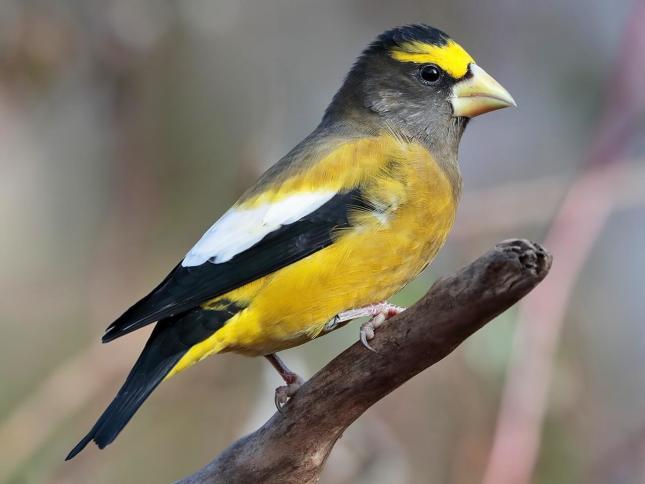
Fun Facts About Evening Grosbeaks
- It’s hard to predict where in the western and northeastern U.S. Evening Grosbeaks will show up in any given winter. When they move into an area, they’re very likely to show up at platform feeders offering sunflower seeds, particularly near forested areas at higher elevations. Out in the woods, you’ll have better luck finding a flock if you listen for their running patter of call notes, which can be sweet, burry, or sharp. In summer you’ll need to be in northern North America or in the mountains of the West, where Evening Grosbeaks breed in coniferous forests.
- In summer, Evening Grosbeaks eat mostly invertebrates such as spruce budworm larvae, caterpillars, and aphids. They also eat a wide variety of seeds—including those of maple, box elder, ash, cherry, apple, tulip poplar, elm, pine, dock, bindweed, and goosefoot—and small fruits, such as ash fruits, cherries, crabapples, snowberries, hawthorn fruits, Russian olive fruits, and juniper berries. They may manipulate fleshy fruits such as cherries in their bills to remove the skin and flesh before cracking and swallowing the seed. Evening Grosbeaks typically feed at the tops of trees and shrubs, but you may see them come to the ground for fallen fruits and seeds or capture aerial insects in flight. They also eat the buds of maple, elm, willow, oak, aspen, and cherry, and drink maple sap by breaking off small maple twigs.
- Evening Grosbeaks are social birds that forage in flocks in winter and break off into small groups or pairs during the breeding season. Evening Grosbeaks show little aggression toward one another throughout the year. At winter feeders males may drive females and younger males away, but they do not defend feeding territories during the breeding season—probably because their food sources are often extremely abundant in local patches. During the nesting season they form monogamous pairs, after courting quietly without any elaborate song or display.
- Breeding birds tolerate other birds nearby but occasionally chase away species such as phoebes, Hairy Woodpeckers, American Robins, and Brown-headed Cowbirds. At feeders, Evening Grosbeaks are often accompanied by redpolls and Pine Siskins that glean the food scraps they leave behind.
- Evening Grosbeaks nest high in trees or large shrubs, such as red spruce, black spruce, Norway spruce, white spruce, Engelmann spruce, white pine, Jeffrey pine, ponderosa pine, jack pine, balsam fir, Douglas-fir, white cedar, paper birch, beech, sugar maple, and willow. T
- The oldest recorded Evening Grosbeak was a male, and at least 16 years, 3 months old when he was found in New Brunswick in 1974.

